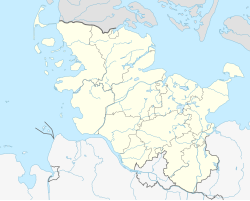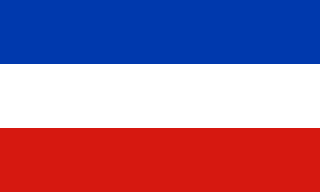
Schleswig-Holstein is the northernmost of the 16 states of Germany, comprising most of the historical Duchy of Holstein and the southern part of the former Duchy of Schleswig. Its capital city is Kiel; other notable cities are Lübeck and Flensburg. It covers an area of 15,763 km2 (6,086 sq mi), making it the 5th smallest German federal state by area. Historically, the name can also refer to a larger region, containing both present-day Schleswig-Holstein and the former South Jutland County in Denmark.

Superphénix was a nuclear power station prototype on the Rhône river at Creys-Malville in France, close to the border with Switzerland. Superphénix was a 1,242 MWe fast breeder reactor with the twin goals of reprocessing nuclear fuel from France's line of conventional nuclear reactors, while also being an economical generator of power on its own. As of 2024, Superphénix remains the largest breeder reactor ever built.
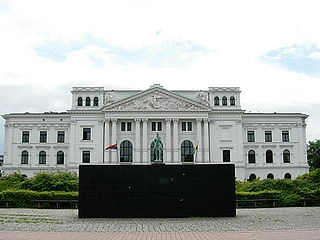
Altona, also called Hamburg-Altona, is the westernmost urban borough (Bezirk) of the German city state of Hamburg. Located on the right bank of the Elbe river, Altona had a population of 270,263 in 2016.

Trojan Nuclear Power Plant was a pressurized water reactor nuclear power plant in the northwest United States, located southeast of Rainier, Oregon, and so far, the only commercial nuclear power plant to be built in Oregon. There was much public opposition to the plant from the design stage. The three main opposition groups were the Trojan Decommissioning Alliance, Forelaws on the Board, and Mothers for Peace. There were largely non-violent protests from 1977, and subsequent arrests of participants.
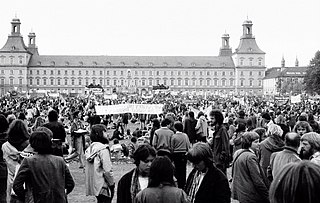
The anti-nuclear movement is a social movement that opposes various nuclear technologies. Some direct action groups, environmental movements, and professional organisations have identified themselves with the movement at the local, national, or international level. Major anti-nuclear groups include Campaign for Nuclear Disarmament, Friends of the Earth, Greenpeace, International Physicians for the Prevention of Nuclear War, Peace Action, Seneca Women's Encampment for a Future of Peace and Justice and the Nuclear Information and Resource Service. The initial objective of the movement was nuclear disarmament, though since the late 1960s opposition has included the use of nuclear power. Many anti-nuclear groups oppose both nuclear power and nuclear weapons. The formation of green parties in the 1970s and 1980s was often a direct result of anti-nuclear politics.
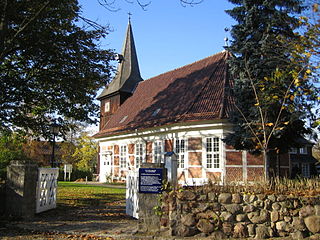
Geesthacht is the largest city in the District of the Duchy of Lauenburg in Schleswig-Holstein in Northern Germany, 34 kilometres (21 mi) south-east of Hamburg on the right bank of the River Elbe.
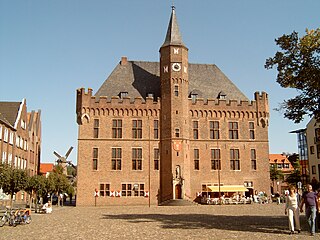
Kalkar (German:[ˈkalkaːɐ̯] is a municipality in the district of Kleve, in North Rhine-Westphalia, Germany. It is located near the Rhine, approx. 10 km south-east of Cleves. The catholic church St. Nicolai has preserved one of the most significant sacral inventories from the late Middle Ages in Germany.
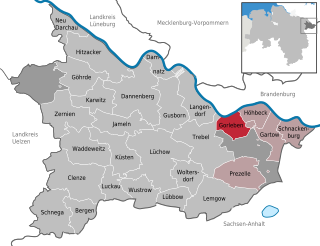
Gorleben is a small municipality (Gemeinde) in the Gartow region of the Lüchow-Dannenberg district in the far north-east of Lower Saxony, Germany, a region also known as the Wendland.

The SNR-300 was a fast breeder sodium-cooled nuclear reactor built near the town of Kalkar, North Rhine-Westphalia, Germany. The reactor was completed but never taken online. SNR-300 was to output 327 megawatts. The project cost about 7 billion Deutsche Mark. The site is now the location of a theme park, Wunderland Kalkar, which incorporates much of the power plant buildings into the scenery.

The Żarnowiec Nuclear Power Plant was to be the first nuclear power plant in Poland. The construction was cancelled due to changes in the economic and political situation in Poland, in the Soviet Union and in the Eastern Bloc and due to the Chernobyl disaster in 1986 and the following years. It was to be located in the former village of Kartoszyno and had its seat in Nadole.

Krümmel Nuclear Power Plant is a German nuclear power plant in Geesthacht, Schleswig-Holstein, near Hamburg. It was taken into operation in 1983 and is owned 50% by Vattenfall via Vattenfall Europe Nuclear Energy GmbH and 50% by E.ON, and operated by the Swedish Vattenfall. Its gross power production is 1,401 MW, using a boiling water reactor.

Brokdorf Nuclear Power Plant is a Power Plant close to the municipality of Brokdorf in Steinburg, Schleswig-Holstein, Germany that shut down on New Year's Eve 2021.
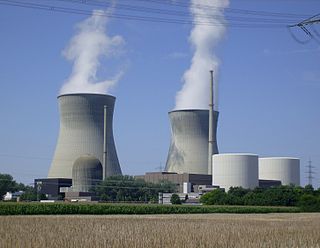
The Gundremmingen Nuclear Power Plant was a nuclear power station in Germany. It was located in Gundremmingen, district of Günzburg, Bavaria. It was operated by Kernkraftwerk Gundremmingen GmbH, a joint operation of RWE Power AG (75%) and PreussenElektra (25%). Unit B was shut down at the end of 2017. Unit C, the last boiling water reactor in Germany, was shut down on New Year's Eve 2021, as part of the German nuclear phase out. However, Gundremmingen unit C as well as the other two German nuclear reactors shut down that day remained capable of restarting operations in March 2022. In November 1975, Unit A was the site of the first fatal accident in a nuclear power plant in Germany, though the accident was unrelated to radiation. After a later major incident in 1977, Unit A was never returned to service.

Hardebek is a municipality in the district of Segeberg, in Schleswig-Holstein, Germany. As of 2021, the mayor is Wolfgang Wilczek, in office since 2018. It has 466 inhabitants, which is a population density of 46.6 /km2.

The anti-nuclear movement in the United States consists of more than 80 anti-nuclear groups that oppose nuclear power, nuclear weapons, and/or uranium mining. These have included the Abalone Alliance, Clamshell Alliance, Committee for Nuclear Responsibility, Nevada Desert Experience, Nuclear Information and Resource Service, Physicians for Social Responsibility, Plowshares Movement, United Steelworkers of America (USWA) District 31, Women Strike for Peace, Nukewatch, and Women's International League for Peace and Freedom. Some fringe aspects of the anti-nuclear movement have delayed construction or halted commitments to build some new nuclear plants, and have pressured the Nuclear Regulatory Commission to enforce and strengthen the safety regulations for nuclear power plants. Most groups in the movement focus on nuclear weapons.

The anti-nuclear movement in Germany has a long history dating back to the early 1970s when large demonstrations prevented the construction of a nuclear plant at Wyhl. The Wyhl protests were an example of a local community challenging the nuclear industry through a strategy of direct action and civil disobedience. Police were accused of using unnecessarily violent means. Anti-nuclear success at Wyhl inspired nuclear opposition throughout West Germany, in other parts of Europe, and in North America. A few years later protests raised against the NATO Double-Track Decision in West Germany and were followed by the foundation of the Green party.
The 1970s proved to be a pivotal period for the anti-nuclear movement in California. Opposition to nuclear power in California coincided with the growth of the country's environmental movement. Opposition to nuclear power increased when President Richard Nixon called for the construction of 1000 nuclear plants by the year 2000.
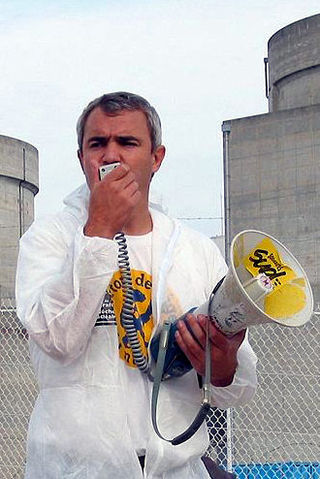
In the 1970s, an anti-nuclear movement in France, consisting of citizens' groups and political action committees, emerged. Between 1975 and 1977, some 175,000 people protested against nuclear power in ten demonstrations.

Anti-nuclear protests began on a small scale in the U.S. as early as 1946 in response to Operation Crossroads. Large scale anti-nuclear protests first emerged in the mid-1950s in Japan in the wake of the March 1954 Lucky Dragon Incident. August 1955 saw the first meeting of the World Conference against Atomic and Hydrogen Bombs, which had around 3,000 participants from Japan and other nations. Protests began in Britain in the late 1950s and early 1960s. In the United Kingdom, the first Aldermaston March, organised by the Campaign for Nuclear Disarmament, took place in 1958. In 1961, at the height of the Cold War, about 50,000 women brought together by Women Strike for Peace marched in 60 cities in the United States to demonstrate against nuclear weapons. In 1964, Peace Marches in several Australian capital cities featured "Ban the Bomb" placards.
The anti-nuclear movement in Russia is a social movement against nuclear technologies, largely stemming from the results of the Chernobyl incident in 1986. During the most active phase of the anti-nuclear movement, from 1988 to 1992, construction of over 100 nuclear projects were prevented on the territory of the Soviet Union. Also, the economic troubles of the 1990s led to a reduction in the number of construction projects. This deprived the anti-nuclear movement of its raison d’être. At the same time, it too was affected by financial difficulties, in particular the lack of donations, which continues to be an issue today. Since the 2000s the Russian Government embarked on highly pro-nuclear policy, with plans to invest billions of dollars in developing the nuclear industry, which leaves the movement with big challenges.



